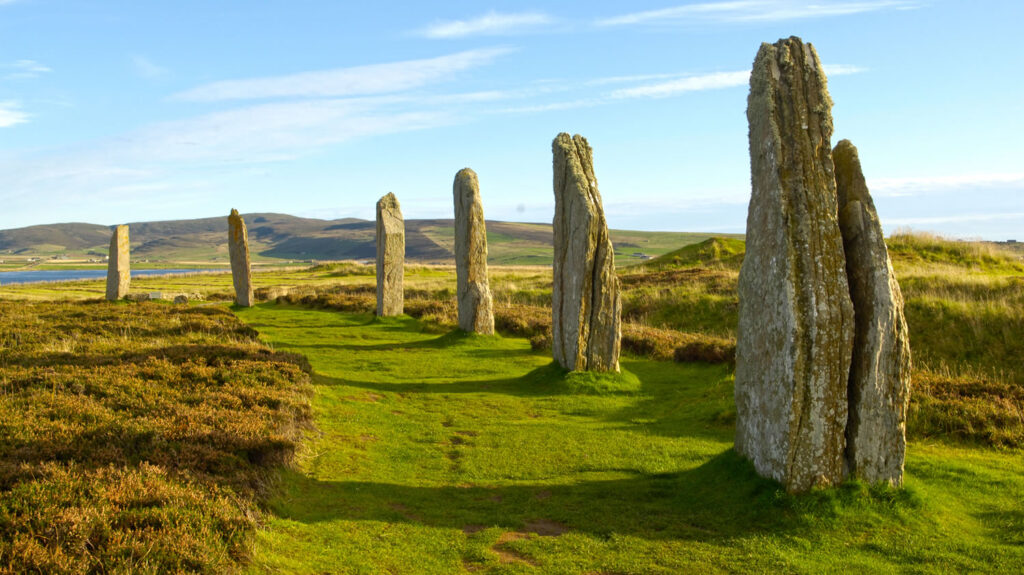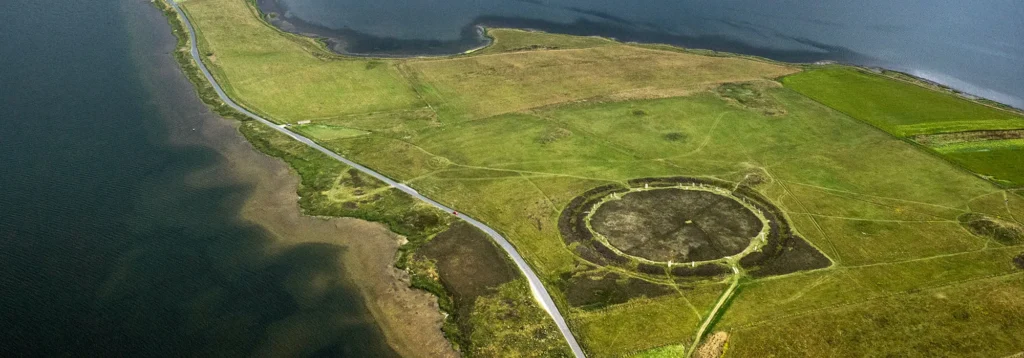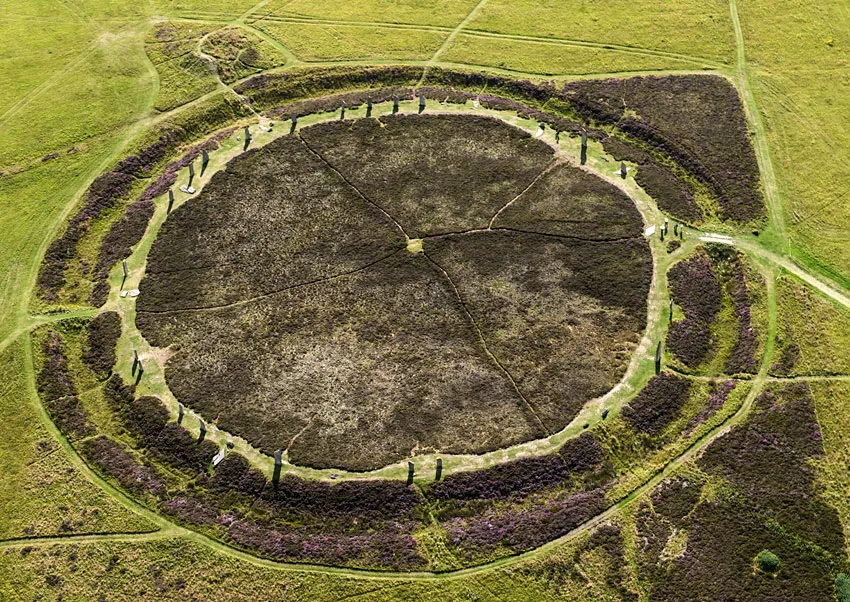The Ring of Brodgar: A Monument of Neolithic Scotland
The Ring of Brodgar is one of the most awe-inspiring and enigmatic prehistoric monuments in Scotland. Situated in the heart of Orkney, this Neolithic stone circle is part of a broader archaeological landscape known as the Heart of Neolithic Orkney, a UNESCO World Heritage Site. With its imposing standing stones, ancient significance, and mysterious origins, the Ring of Brodgar continues to capture the imagination of historians, archaeologists, and visitors alike.

Geographical and Archaeological Context
The Ring of Brodgar is located on Mainland, the largest island of the Orkney archipelago, between the Loch of Harray and the Loch of Stenness. It is the northernmost stone circle of its type in the British Isles, and at approximately 104 meters in diameter, it is one of the largest in the UK. The monument is surrounded by a natural amphitheater of rolling hills, creating a dramatic and evocative setting.
The site consists of a massive circular ditch enclosing a ring of standing stones. Originally, there were 60 stones, but today, only 27 remain standing. The stones vary in height, with the tallest reaching around 4.7 meters. The surrounding ditch, which was carved out of bedrock, is about 3 meters deep and 9 meters wide, emphasizing the effort and engineering prowess of its Neolithic builders.

Historical and Cultural Significance
The Ring of Brodgar is estimated to have been built between 2500 and 2000 BCE, during the Late Neolithic period. It forms part of a complex ceremonial landscape that includes other significant Neolithic sites such as the Stones of Stenness, the Ness of Brodgar, and Maeshowe. The alignment and purpose of these sites suggest that they were used for religious or astronomical purposes.
Many theories exist about the function of the Ring of Brodgar. Some scholars suggest it was a temple or ritual space used for ceremonies related to the seasons, fertility, and the cycles of life and death. Others propose that it served as a gathering place for social or political events. Given its vast scale, it likely held great importance for the Neolithic people of Orkney.
Construction and Engineering
The construction of the Ring of Brodgar was a monumental undertaking, requiring significant planning, labor, and resources. The stones had to be quarried, transported, and erected without the use of metal tools or wheeled vehicles. It is believed that local sandstone was sourced from quarries within the Orkney Islands, possibly from locations such as the cliffs of Yesnaby or other nearby outcrops.
The ditch surrounding the circle was cut into solid bedrock, an extraordinary feat considering the Neolithic people only had basic tools made of stone, bone, and wood. This indicates a highly organized society capable of mobilizing large groups of people for communal projects.
Theories and Interpretations
The exact purpose of the Ring of Brodgar remains unknown, but several theories have been proposed:
- Astronomical Observatory: Some researchers believe that the Ring of Brodgar was aligned with celestial events such as solstices and equinoxes. The positioning of the stones may have been used to track the movements of the sun, moon, and stars.
- Ritual and Ceremonial Site: Given its size and location within a wider ritual landscape, it is likely that the Ring was a center for religious ceremonies, processions, and rites of passage.
- Meeting Place or Social Hub: Some archaeologists suggest that the site may have been used for gatherings, trade, or as a neutral ground for different Neolithic communities.
Whatever its original function, the monument reflects the sophisticated culture and spiritual beliefs of its builders.
Excavations and Discoveries
Unlike other Neolithic sites in Orkney, the Ring of Brodgar has not been fully excavated. However, archaeological surveys and limited excavations have provided valuable insights. Pottery fragments, tools, and evidence of hearths have been discovered in the surrounding area, suggesting human activity linked to the site.
Recent studies at the nearby Ness of Brodgar have uncovered an extensive Neolithic complex with structures, artifacts, and evidence of feasting. This has led some experts to speculate that the Ring of Brodgar may have been part of a broader network of ceremonial and domestic sites.
Legends and Folklore
As with many ancient sites, the Ring of Brodgar is shrouded in legend and folklore. One popular tale tells of how the stones were once giants who were turned to stone by the rising sun. Another story suggests that the site was used for mystical rituals involving fairies and other supernatural beings. These myths add to the site’s sense of mystery and wonder, linking the past with cultural traditions that persist to this day.
Preservation and Modern Significance
The Ring of Brodgar is now protected as part of the Heart of Neolithic Orkney World Heritage Site, which also includes Skara Brae, Maeshowe, and the Stones of Stenness. Conservation efforts focus on protecting the monument from erosion, weathering, and human impact. Visitors are encouraged to respect the site by staying on designated paths to minimize damage.
Today, the Ring of Brodgar continues to be a place of inspiration, drawing historians, archaeologists, and tourists from around the world. It remains a symbol of Orkney’s rich prehistoric past and a reminder of the ingenuity and spiritual depth of its Neolithic inhabitants.
Conclusion
The Ring of Brodgar stands as one of the greatest Neolithic wonders of the British Isles. Its precise purpose may never be fully understood, but its significance as a sacred, social, or astronomical site cannot be doubted. As ongoing research and discoveries unfold, the Ring of Brodgar will continue to intrigue and inspire those who visit, ensuring that its mysteries endure for generations to come.

